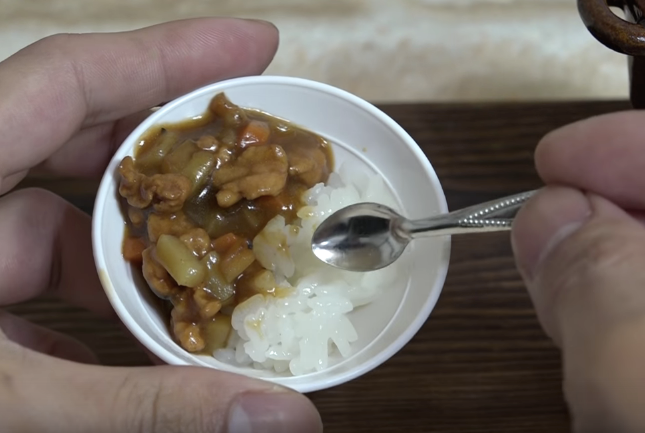Soothe Yourself By Watching Tiny Meals Being Cooked in Tiny Kitchens

A screenshot from Miniature Space’s sushi-making video.
Here’s a novel option if you’re stressed out and seeking a way to relax: fire up YouTube and lean in close to see human hands making tiny meals for tiny invisible diners.
Japanese miniature cooking videos, in which hands appear in a dollhouse-esque kitchen to prepare minuscule meals, are slowly becoming an internet sensation. One channel, Miniature Space, features the hands of an unknown chef making everything from sushi to croquettes to custard, all on a scale that requires tiny tools, steady fingers, and a lot of patience. The videos, each a few minutes long, all have hundreds of thousands of views.

Lilliputian curry, anyone? (Screenshot from Miniature Space’s curry video.)
Part of the appeal of these videos is in seeing how inventive the mysterious kitchen whizzes can be with the real food they use. To make it look realistically scaled-down, the chefs cut human-sized food into diminutive portions using teensy knives. In the case of the sushi-making video, that means shaving off the merest sliver of tuna, then rolling it into a cylinder of seaweed and vinegar-splashed rice that’s about half the width of the chef’s index finger. The precise, orderly approach is fascinating to watch.
It’s also calming. Miniature Space’s videos fall into the serenity-inducing category of “ASMR.” ASMR, or Autonomous Sensory Meridian Response, is the name that has been given to a pleasant, soothing feeling that some people feel when they encounter others demonstrating a process or performing a methodical task. Often, the task involves intense focus and soft sounds such as clicks, tapping, and scratching. The “ASMR feeling” usually incorporates a tingling sensation in the neck, scalp, or back of the head.
Ever since the term “ASMR” was coined in 2010, a rash of “ASMRtists” have been uploading videos to YouTube in which they attempt to induce tingles in viewers via whispering, tapping, and performing procedural role-plays. These are known as “intentional ASMR.” The Japanese cooking videos, however, can be considered “unintentional ASMR,” because they were not created to trigger tingles in the viewer.
Robert Duff, a psychotherapist who creates ASMR videos for his YouTube channel Duff the Psych, says unintentional ASMR videos that involve miniature cooking can be “relaxing, stress relieving, anxiety combating, or sleep facilitating.” And they don’t necessarily have to involve real food to induce such feelings. It’s more about the careful nature of the processes involved.
Another Japanese YouTube channel, formerly known as RRCherryPie and now known as Nameless, creates cooking videos that make use of miniature plastic food items and utensils. One video, which chronicles the making of tiny bento boxes, has amassed an astounding 145 million views.
In this video, the light clicking sounds are a big ASMR trigger, says Duff. There is also another element that brings on the tingles: make-believe. Pretending to make dinner using dollhouse miniatures is “the sort of thing that might remind you of childhood,” says Duff—a childhood in which someone is “very specifically focused on a task and demonstrating the activity with much care.” By inducing a return to a simpler, more innocent time, such behavior can have a soothing effect on those who report experiencing ASMR.
Beyond the tingle factor, miniature Japanese cooking videos also demonstrate an impressive level of attention to detail. Miniature Space and Nameless’ videos both make use of finely detailed miniatures made by the Japanese company Re-Ment, whose name is short for “reform the entertainment.” Re-Ment cooking miniatures are designed to take you through the entire process of a make-believe meal.
Take the Nameless cooking video, for instance, in which the chef makes tempura shrimp. There are three varieties of the Re-Ment shrimp miniature shown: a raw one, a version that has been battered and breaded, and one that has been deep fried.

And you thought your kitchen was small. (Screenshot from Miniature Space’s cheeseburger video.)
It’s this thorough attention to detail that makes Re-Ment particularly appealing to fans of tiny props. Susan Chi, an artist who is drawn to miniatures because she has “always been fascinated with the details and the creative ways to add realism in small scale,” says she likes to study Re-Ments to get ideas on texture and detailing for when she makes her own miniatures. Online communities like the Re-Ment Addicts group on Flickr post macro photos of their sets, often carefully set up in dollhouse environs, and debate the finer details of each new Re-Ment offering on message boards.
The fascination factor of these Japanese videos may vary according to the viewer’s interests and propensity for feeling tingles, but the care and creativity behind them is remarkable regardless. Here are a few more examples of the itty-bitty culinary artistry being served up:
Gastro Obscura covers the world’s most wondrous food and drink.
Sign up for our regular newsletter.













































Follow us on Twitter to get the latest on the world's hidden wonders.
Like us on Facebook to get the latest on the world's hidden wonders.
Follow us on Twitter Like us on Facebook